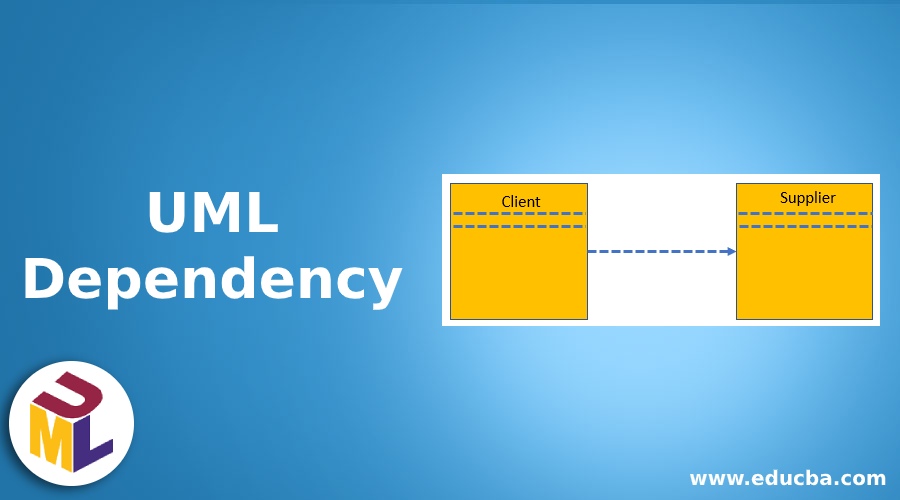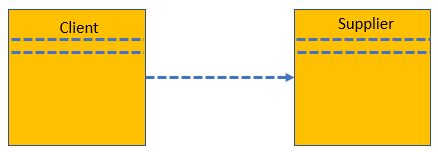Updated March 31, 2023

Introduction to UML Dependency
Dependency is established within a range of elements that need other model components for the unique specification for implementation in UML. The model component is dependent on the self-determining model components which are known as the supplier. Multiple components are established to form a relationship called tuples. The dependency in UML is represented by dashing line directing the client which is a dependable source to supplier component which is an independent source. The arrow in the line denotes the dependency which represents the direction denotes the direction of the relationship and doesn’t represent the direction of the process.
What is UML Dependency?
- The term dependency is referred to as a directed relationship that is used to represent some UML components or a range of elements which depends on other model components for implementation or specification. Due to this dependency is referred as client-supplier relationship, here the supplier gives some information to the client and the components of the client’s face some incomplete views with semantic ideas and is structurally depends on a supplier for more data.
- The alteration of supplier effects the elements of clients. Named components are used to establish the relationship among dependencies. Here the UML includes many different types of components such as interface, class, packages and artifacts. There are many dependencies established among different components. The relationship in UML is used to denote the association between different things. It is named as a link that explains the process between the relation of two or more objects at the time of execution in a system.
- The grouping of objects in structural and behavioral states in UML is termed as the establishment of relationship. The UML is comprised of three important elements such as things, relationship and diagram representation. The fundamental building components of the model is provided by things. A relationship is a term in UML which is used to represent how things are related to each other.
- The graphical representation of gathered elements that are grouped and related is described by diagrams. The architecture of dependency in UML involves client and supplier. It is implemented in component figures, class diagrams, use-case figures, and deployment diagrams that denotes any modulation to supplier the amenities to make any changes to clients. In UML, the dependency is an important case which is used by the client and supplier to depict how different things that lie within a system works relied on each other.
As shown in the below diagram, the client and supplier are dependent on each other and are represented by dotted lines.
Types of UML Dependency
The types of stereotypes, keywords, dependencies and relationships are given below:
- Derive: It is limited which denotes the template can be started by any source at the targeted location by using all the input parameters. It also denotes the location of the source object which is computed from the target object.
- Friend: The individuality of source placed in the target object.
- InstanceOf: It describes the ability of the source object, which is used to develop many instances of a target object.
- Instantiate: It describes the ability of source object by developing many instances of the target.
- Refine: It defines the source which satisfies the exceptional abstract values than the target object.
- Use: If the packages are developed in XML, the usage of stereotype defines the composition of the source package. These packages exist in the target package which specifies the usage of some elements available in the target package.
- Substitute: It swaps the stereotype where the client is the runtime which is fed from the supplier.
- Access: It is known as a private combination. Here the source package permits access to an element of target package.
- Import: The option represents the target which imports the package from source component which is described within the target source. It is also called a public combination.
- Permit: It defines the source element that enables the supplier component or visibility is given by the supplier.
- Extend: It defines the character of the source component that can be protracted by the target.
- Include: It explains the source component which involves the character of another component at the concerned location that is similar to a function call in C++ and C.
- Become: It defines the target which is identical to the source with unique values and roles.
- Call: It defines the target object which can be called by the source.
- Copy: Here the target is independent replication of source object
- Parameter: It defines the parameter of supplier of which is based on the action of the client.
- Send: The client works as per the operation of the indeterminate target to the supplier.
- Call2: The operation of client calls the operation of the supplier
- Create: The classifier of the client creates many instances from the classifier of the supplier.
- Trace: The components of clients are used to track the suppliers. It can be used for different levels of requirement.
Importance
UML is famous for illustrative notations. UML is used for specifications, visualization, construction, documentation of the software elements in both non-software and software systems. Since the visualization is a significant part that needs to be clearly interpreted and understood. The UML notations are significant components in modelling. The appropriate and effective use of notations is mandatory for making a meaningful and complete model. The developed model becomes useless if its purposes are not defined and depicted clearly.The learning notations should be underlined from the initial stages.
The varied notations become accessible to establish a relationship and learning things. The UML figures are used to represent those particular objects and relationship. The remarkable feature that makes UML more flexible and powerful is due to its extensibility. The graphical notations that are used to represent the structural things of the most used nouns in UML models. The structural things are represented as objects, interfaces, classes, use cases, active classes, components, nodes and collaborations.
Recommended Articles
This is a guide to UML Dependency. Here we discuss the introduction to UML Dependency, what is UML dependency along with its types and importance. You may also have a look at the following articles to learn more –

